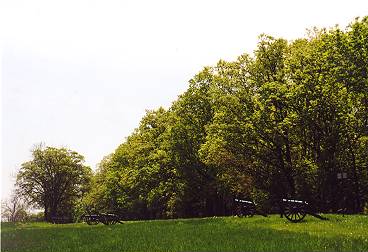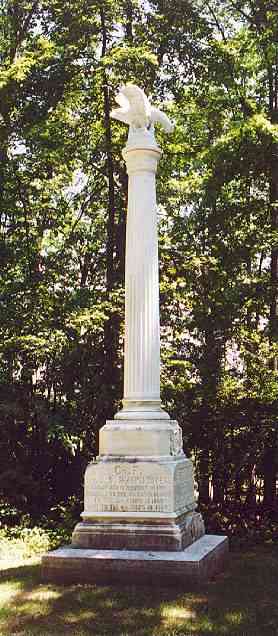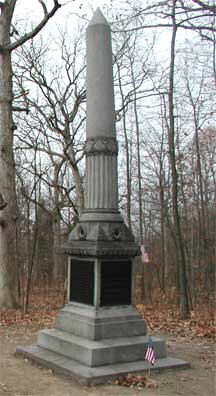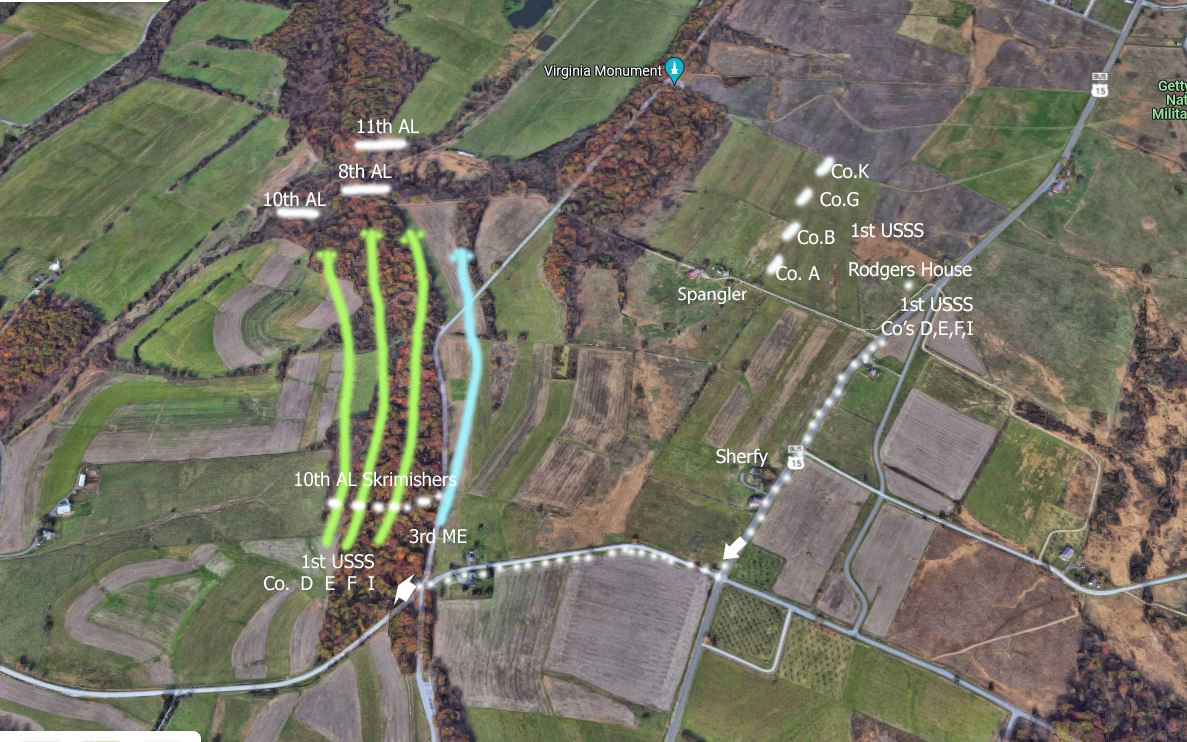
Pitzer Woods
 |
Owned at the time of the battle by Samuel Pitzer, this plot of oaks and maples stands at the southern tip of Seminary Ridge and marks its juncture with Warfield Ridge. The woods had no significance at all to the Gettysburg landscape until certain events took place here on July 2. Just prior to midday, the 1st United States Sharpshooters were ordered by Major General Daniel Sickles, commander of the Union Third Corps, to scout this patch of woods. Accompanied by members of the 3rd Maine Infantry, the sharpshooters encountered Alabama soldiers from Brig. General Cadmus Wilcox's Brigade. A brisk fire fight broke out and though it lasted only about twenty minutes, the Union soldiers withdrew with the knowledge that the woods on Seminary Ridge were teeming with Confederates. Retreating to Cemetery Ridge, they reported their encounter to General Sickles. Sickles realized that the number of Confederates in those woods meant only one thing- an attack on his position on Cemetery Ridge from the west. Sickles sent a courier to General Meade with the information, followed by another courier a half hour later. Another hour passed and having received no response from Meade, Sickles decided to advance his corps to the Emmitsburg Road, the only high ground between the two ridges. This controversial decision separated his corps from the remainder of the Union army, which still lay on Cemetery Ridge.
Samuel Pitzer's farmhouse still stands west of this area and is today part of Eisenhower National Historic Site. The size and shape of this wooded area has changed very little since the battle.
Berdan Avenue
 Co. F, 1st USSS Monument |
Also within Pitzer Woods is Berdan Avenue, which leads from West Confederate Avenue to a small cul-de-sac where three monuments stand. Two of these honor companies of the 1st Regiment United States Sharpshooters.
At Gettysburg, Company F (Vermont troops) 1st Regt. USSS, was one of the companies sent
forward by General Sickles to reconnoiter the front of the Third Corps. It was at the spot
where their monument sits that the sharpshooters engaged several regiments of General
Cadmus Wilcox's Brigade.
During this fight Captain McLean of Co. D was mortally wounded, he couldn't
be carried back when the sharpshooters started to fall back under heavy
Confederate pressure. Peter H. Kipp stayed with his Captain to insure good
treatment by the Confederates. As his captors marched him to the rear, he saw
how devastating their rifles had been. He saw Confederate surgeons trying to aid
their wounded and stated the following;
"It is impossible for me to describe the slaughter we had made in their ranks. In all my past service, it beat all I had ever seen for the number engaged and for so short a time. They were piled in heaps and across each other. I got to where the surgeons were dressing the wounded, I saw hundreds of men there. The doctor would hardly believe there were so few of us fighting them, thought we had a corps, as he never saw lead so thick in his life as it was in those woods. But when I told him who we were, said that accounted for it, as he claimed the Sharpshooters were the worst men we have to contend with".
A monument known as "The New York Monument" also sits in this area, survivors of the four New York Companies, A, B, D and H dedicated it on July 2, 1889.

New York Monument
1st USSS movement to Pitzers Woods
Lieutenant-Colonel,
Comdg. First U.S. Sharpshooters,
C. TREPP, was not happy about how he was to move and commented on it in his
report.
Early
in the morning of July 2, this regiment was posted so, and with instructions, to
protect the left flank of the Third Corps. Soon thereafter the dispositions were
changed, and I received an order to send 100 men on a reconnaissance in front of
the right of the Third Army Corps. This detachment I conducted in person, and
deployed them. The command was given to Capt. John Wilson, a very efficient
officer, and I returned to the regiment. I then received another order for 100
men for a reconnaissance. Following the aide-de-camp, I conducted this second
detachment directly to and followed the road in plain view of the enemy. This
detachment might have been marched from the original position to a point where
the engagement took place perfectly concealed from view of the enemy and without
loss of time. As we marched, the enemy must have seen every man from the time we
reached the road until we entered the woods on the Fairfield road, giving the
enemy time enough to counter-maneuver. The enemy gained yet more time by reason
of the Third Maine, Colonel Lakeman,
who supported us, halting on the Emmitsburg road, according to his
instructions.
All this time we were marching or
halting in plain view of the enemy. For this violation of rules of secret
expeditions we paid dearly, for when we entered the woods, advancing as
skirmishers, we met the enemy's skirmishers very soon after crossing the
road. The position of the companies of my regiment was, D and E on the left,
F and I on the right, Third Maine as reserve. We drove the enemy about 300
yards, when he made a stand behind a rail fence. The firing was very brisk
for about ten minutes, during which time we maintained our position. Col. H.
Berdan then gave the order to fall back, firing, which was done in good
order, the enemy pursuing a short distance.
This command was collected and
formed on the Emmitsburg road, having lost 1 commissioned officer killed, 2
officers wounded, and 16 enlisted men killed, wounded, and missing.
With the balance of this command,
I was then posted as a support to Capt. J. H. Baker's line of skirmishers
from this regiment, in front of the center of the Third Army Corps.
On examining the ammunition of my
detachment, I found that we had not more than about 5 rounds per man. At the
time the heavy cannonading began, Col. H. Berdan ordered this detachment to
fall back to the Position of the morning.
